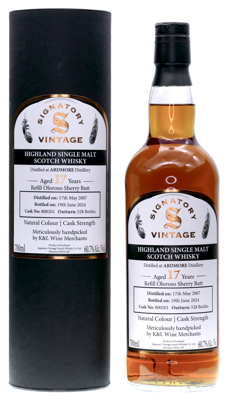|
|
Release Notes
Ardmore is widely underappreciated, the reasons for which are not always clear. They make a beautiful peated Highland style, but the owners spend almost no time selling it. Maybe, they want to focus on their other peated properties like Bowmore and Laphroaig, or perhaps the Ardmore is such a crucial part in so many popular blends, they don’t have the stock. But we always want more -Ardmore. When we do see Ardmore, it is typically in refill (3rd+ fill) ex-bourbon and hogsheads diverted from the blender’s grasps. Only two other sherried Ardmores have ever been sold at K&L, one was a Scott's Selection from 1977 and the other a gorgeous Gordon & MacPhail 17-Year-Old Refill Sherry Hoggie. This stupendous 2nd fill sherry butt is of equal if not greater quality than that splendid G&M bottling yet we're charging a full $70 less! The implications of that fact are truly astounding when you consider that the G&M at $140 was in 2020 dollars, so closer to $170 today. All that before we start talking about how lovely this old sherry butt is. Extremely complex without the subtlety of other Ardmores, the powerful earthy smoke melds wonderfully with fragrant yet subtle sherry -orchard pears, citrus oil, and roasted nuts. Then wet rocks, ash, forest floor mingle with hints of fresh rubber, kippers, and roasted spices. It loves air and water and needs tons of time to unwind, but when it does it might just be the best value in peated whisky of 2024.
K&L Wine Merchants
One of 528 bottles drawn from Refill Oloroso Sherry Butt #800201 on 19th of June, 2024. Originally distilled on May 17th, 2007.
From the Bottle
The Bottler: Signatory Vintage
| Established: 1988 |
| Silent since: False |
| Address: Edradour Distillery, Pitlochry, Perthshire & Kinross, PH16 5JP, Scotland |
Signatory owns the smallest distillery from Scotland, Edradour since 22 july 2002
In April 1992, as the company began to grow, they moved to much larger premises. Here, they were granted a licence to bottle their own products on site. They set-up a small line bottling system, primarily geared towards the bottling of single casks. Although the actual bottling of whisky is semi-automated, the emphasis is very much a hands-on operation, with hand labeling and packing of products. To add to the exclusivity of their bottlings, they often declare the cask number, date of distillation,and date of bottling on our labels. In addition,each bottle is individually hand numbered.
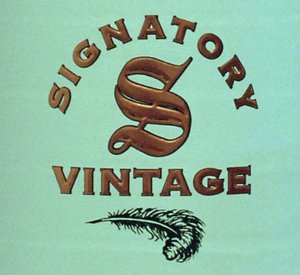
It is their aim, as an independent bottler to offer a range of whiskies, some of which are not bottled by the proprietor of a particular distillery, and some at different ages/strengths to those offered as distillery bottlings. The majority of their bottlings are the product of single casks, with the malt whisky enthusiast being given the opportunity to sample the subtle differences which occur with each different cask.
The name of Signatory derived from the fact that their initial intention was to find someone famous to sign the labels for bottles produced from one single cask. The first cask we purchased was a cask of 1968 Glenlivet, which was sold long before we could find a famous person.
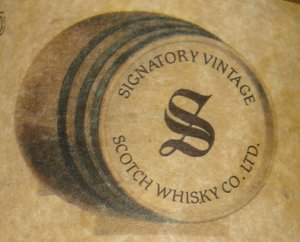
Until April 1992, when they moved to their current premises in Newhaven (Edinburgh), they operated from a bonded warehouse in Leith. Leith was once a well known port for importing wine from France. As this industry declined, many of the whisky companies began to occupy the old warehouses for cask storage purposes. In recent years, this has also declined, with the larger companies moving to the west of Edinburgh, where transport links are better.
The company was founded in 1988. It is a family owned and managed company, being one of only three true independent bottlers. They always like to draw a distinction between the independent companies who bottle their own products, and the independent companies whose products are bottled under contract. The other fully independent bottlers are: Gordon & MacPhail and Wm. Cadenhead.
from Whisky-Distilleries.info
The Distillery: Ardmore
| Established: 1898 |
| Silent since: False |
| Address: Kennethmont, Huntly, Aberdeenshire, AB54 4NH, Scotland |
| → website |
In the new Millenium
The Ardmore distillery is located in the far South-East of the Speyside region. Actually, this Ardmore isn"t the first distillery to carry the name. Between 1817 and 1835 there used to be another "Ardmore" distillery on the island Islay. That one was closed & incorporated by Lagavulin in 1837.
The distillery has been expanded not once but twice since WWII. The original number of two stills was doubled to four in 1955 and then doubled again in 1974 to a grand total of eight. With a malt storage capacity of +/- 1,000 tonnes, a 25 feet mash tun and 14 wooden wash backs with a total capacity of 90,000 litres the four wash stills receive a constant flow of wash. Like the wash stills, the four copper spirit stills hold 15,000 litres each. All this fancy equipment is responsible for an annual output of (hold on...) more than 3,000,000 litres of pure alcohol each year. Pretty impressive, eh?
Until the 1970"s barley was malted on the premises, but like so many other distilleries the Ardmore distillery depends on specialised maltsters these days. Rumour has it that Ardmore uses relatively heavily peated barley, which may account for the rich, powerful character of the malt whisky produced there. The original distillery maltings were converted into warehouses and a filling store some time ago, but Ardmore still has its own cooperage.
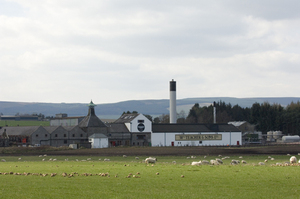
Ardmore is actually one of the largest distilleries in Scotland.
The current Ardmore distillery is located at the edge of the Grampian mountains. It was built in 1898 by Adam Teacher, son of William. Even today, most of the whisky the distillery produces is reserved for the Teacher"s blends which get a lot of their malty character from the Ardmore malt whisky. Bottlings of Ardmore as a single malt are relatively rare.
Ardmore was founded during one of the industry booms at the end of the 19th century. It was actually quite modern at the time; the entire distillery was powered by a single steam engine and a railway ran alongside the buildings. This was convenient when it came to the transport of supplies like barley and coal. Until 2002 the stills at Ardmore were heated by the traditional coal fired furnaces, but like most other distilleries they use internal heating now.
Even more impressive: they could produce 4,200.000 litres "on full steam".
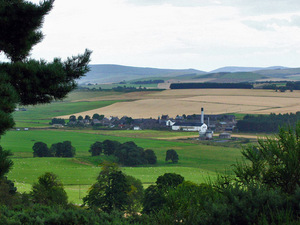
Think about it; if you wanted to you could fill many king size swimming pools with that. But why would you? The malts (and the Teacher"s blend) are much better suitable for drinking than for swimming. Well, at least I assume they are; I"ve got quite some experience in the drinking department but I"ve never actually tried the swimming...
2002 - In 2002 Ardmore was one of the last distilleries in Scotland to switch from coal firing (direct heating) to steam heating (indirect heating).
2005 - Beam Global Spirits & Wine (a.k.a. Jim Beam Brands) purchases a number of distilleries and brands from Allied, including the Laphroaig distillery on islay. They manage their distilleries via the "Fortune Brands" company.
2007 - the first official bottling in quite some time is launched; the Ardmore "Traditional Casks".
Trivia:
- Like many distilleries, Ardmore has a name with Gaelic origins. It means "big headland".
- Ardmore has its own cooperage for the production and repair of casks.
- Ardmore is one of almost two dozen malt whisky distilleries that were founded during the "whisky boom" of the late 19th century and which have managed to survive until this day. The other survivors include Aberfeldy, Aultmore, Balvenie, Benriach, Benromach, Bruichladdich, Bunnahabhain, Craigellachie, Dalwhinnie, Dufftown, Glendullan, Glenfiddich, Glen Moray, Glenrothes, Glentauchers, Knockandu, Knockdhu, Longmorn, Tamdhu and Tomatin.
from Malt Madness
The Owner: Fortune Brands
| Established: 1890 |
| Silent since: False |
| Address: Fortune Brands, Inc., 520 Lake Cook Road, Deerfield, IL 60015 |
| → website |
By the late 1990s, Fortune was rather different from what it had been ten years earlier. After getting rid of its tobacco holdings, Fortune began buying up companies in the home and office products area, such as Schrock Cabinet Co. and Apollo Presentation Products, a maker of overhead projectors. It also bought in the liquor segment, picking up Geyser Peak Winery in 1998 and entering an agreement in 1999 with two European liquor companies to jointly distribute their spirits worldwide. Fortune also vowed to better manage the brands in its portfolio, and in 1999 took a charge of $1.2 billion to restructure and write down goodwill. The company also announced it would cut costs by reducing its corporate staff by one-third and moving its headquarters to Lincolnshire, Illinois, where its office products division already was located.
From the complex dissolution of American Tobacco, designed and overseen by James Duke himself, came the elements of the modern tobacco industry. Spun off as new corporate entities were Liggett & Meyers, Lorillard, R.J. Reynolds, and a new, smaller American Tobacco Company. With the exception of Reynolds, these companies were given assets in all phases of the tobacco business, and Reynolds, the youngest and most aggressive of the companies, soon acquired what it lacked. Control of British-American Tobacco was lost to the British, where it has remained. Duke turned over direction of American Tobacco to Percival S. Hill, one of his veteran lieutenants, and himself went with British-American as chairman and one of its directors. The founder retained large holdings of stock in each of the newly formed spin-offs and, upon his death, left a great deal of money to the eponymous Duke University and a score of other charitable causes.
The immediate postwar years were good for American Tobacco, which upped its overall share of the domestic tobacco market to 32.6 percent in 1953. However, that would prove to be the high-water mark for the company"s cigarette business. In the long run, however, American Tobacco"s relative failure in cigarettes may have been a blessing. Beginning in the mid-1960s, the company used the steady cash flow from its remaining tobacco business to make a number of promising acquisitions. Chief among these were Gallagher Ltd., one of the United Kingdom"s largest tobacco companies; James B. Beam Distilling Company; Sunshine Biscuits; Duffy-Mott; and several makers of office products. In recognition of the company"s changing profile, it was renamed American Brands in 1969, by which date its share of the domestic tobacco market had slipped to 20 percent and continued to decline. After a handful of other minor acquisitions, American Brands made its largest purchase in 1979, buying The Franklin Life Insurance Company, the tenth largest life insurer in the United States. By that time, non-tobacco assets were generating one-third of American Brands" operating income of $364 million, and the company"s diversification program generally was regarded as a modest success.
Duke"s control of United Cigar Stores" more than 500 outlets gave the public a clearer picture of the extent of Duke"s domain, and his company soon faced rising criticism and opposition, some of it violent. Those in both the industry and the public had reason to dislike Duke and his cartel; Kentucky tobacco growers, for example, their prices repeatedly lowered by the single large buyer in town, banded together in 1906 to burn down a number of the trust"s large tobacco warehouses. More serious was the increasing pressure brought to bear by the U.S. Department of Justice, which took heart under the administration of President Theodore Roosevelt and began a series of antitrust actions against the industrial combines. In 1907, the department filed suit against Duke"s creation, now once again called American Tobacco Company, and in 1911 the Supreme Court agreed that the trust must be dissolved to restore competition to the tobacco industry. Total corporate assets were estimated at more than $500 million.
Fortune Brands traces its origin to the remarkable career of James Buchanan (Buck) Duke, founder of The American Tobacco Company. Duke was born in 1856 on a small farm outside Durham, North Carolina, where his father, Washington Duke, raised crops and livestock. The Duke farm was ravaged by armies of both North and South at the end of the Civil War, and upon his release from a military prison Washington Duke found that his sole remaining asset was a small barn full of bright leaf tobacco. Bright leaf, so called because of its golden color, had been introduced only recently, but its smooth smoking characteristics were already making it a favorite, and its fame was soon spread by the returning war veterans. Duke set out to peddle what leaf he had, and, pleased with the response, he quickly converted his land to tobacco culture, selling his wares under the name Pro Bono Publico, meaning "for the public good" in Latin. In its first year of operation, W. Duke & Sons sold 15,000 pounds of tobacco and netted a very handsome $5,000.

Duke had grown to dominance of the cigarette business in a single decade and, shortly, was to duplicate the feat worldwide. Though triumphant, Duke was faced with the prospect of continuing bitter competition and restricted profits. The 32-year-old veteran thereupon proposed a solution that was startling in scope: to merge all five of the competitors and, by joining forces, bring to an end the wasteful price warfare. His fellow manufacturers at first balked at the initiative, but they eventually agreed and in January 1890 formed The American Tobacco Company, its $25 million in capital divided among ten incorporators, with J.B. Duke named president. The new company, one of the first true combinations in the history of U.S. business, controlled 80 percent of the nation"s cigarette business and showed a net profit of $3 million in its first year.
Fortune Brands, Inc., is a widely diversified conglomerate with principal businesses in distilled spirits, home products, hardware, office supplies, and golf equipment. Most of its brands are either number one or number two in their market categories. Fortune"s brands include Jim Beam, the world"s best-selling bourbon, Swingline staplers, Acco paper clips, Master Lock padlocks, Moen faucets, and Titleist and Pinnacle golf balls. Fortune was a major player in the tobacco industry until the late 1990s, when it sold its domestic and foreign tobacco interests and got out of that business entirely. Nearly 20 of the company"s brands generate more than $100 million in sales.
In 1991, American Brands strengthened its hold on the distilled spirits market by acquiring seven brands from the Seagram Company. American spent $372.5 million for the brands, which represented approximately one-quarter of giant Seagram"s sales in the United States. In the midst of a turndown in liquor consumption, Seagram had decided that those who were drinking less should drink better. Thus, it wanted to unload some of its less prestigious brands. American, however, was deliberately pursuing the opposite tack, aiming for more budget-conscious consumers. The brands it took over from Seagram were the American whiskies Calvert Extra and Kessler, Canadian whisky Lord Calvert, Calvert gin, Ronrico rum, Wolfschmidt vodka, and Leroux liquor. The acquisition made American"s subsidiary Jim Beam Brand Company the third largest spirits company in the United States. American"s strategy seemed profitable. Though its new liquor brands and its tobacco brands lacked both snob appeal and great market share, they did make money. Profits rose to record levels in 1991, with a rise of almost 40 percent for the year. Liquor sales, bucked by the Seagram acquisition, rose 12 percent, and tobacco sales rose all of 1 percent. This small rise, however, was the first increase for American since 1965.
The company then changed its name in 1996, from American Brands to Fortune Brands. This came after the company sold the last vestige of its tobacco business, its British unit, Gallagher. The company was concerned that investors still associated its old name with a tobacco company. For example, when a smoker in Florida won a substantial jury award against another tobacco company in August 1995, American"s stock suffered. The newly named company"s CEO, Thomas Hays, explained the rationale behind the choice, saying, "People talk a lot about something being fortunate or making a fortune, which is certainly what we want to do for our shareholders" (from a December 9, 1996 interview in Fortune magazine).
from FundingUniverse.com
